I made an important decision last week. As much as I love my current WIP, I don't think I can sell it. But I have an idea for a MS that I think will be great. So to stay on track for my goals for this year, I need to put in some really focused time on my new idea. So I'll be taking a break from blogging through the end of March.
I'll miss all of you, but I plan to use my time well, and be back either April 1st, or mid-April.
Have a good month.
Melissa
Monday, February 21, 2011
Friday, February 18, 2011
Fixtureless Friday
"Perfection is achieved, not when there is nothing more to add, but when there is nothing left to take away."
- Antoine de Saint Exupery
Someone e-mailed me this quote today, and it's perfect for what I want to post about.
(I'm taking a break from foenetic friday again.)
I've always read that as a writer we shouldn't be afraid to "kill our darlings." And I totally agreed with that. My philosophy is that a great book is XX,000 perfect words, in the perfect order, with nothing added and nothing left out. So when people asked if I would be willing to "kill my darlings," I said, "sure, if they aren't part of the XX,000 perfect words, they've got to go.
I never had any real darlings, but what I did find was a scene that had become a "fixture." You know, that ugly light fixture that you've just gotten used too. The one you don't even notice anymore, until the realator asks, "Are you going to replace that before we list the house?"
I finished reading the great book "Save the Cat," and after reading it, went through one of my older manuscripts. I found a glaring "fixture," a scene that wasn't terrible, but it was just sitting there taking up space. It was one of the few scenes that hadn't changed much from the earliest version. It just stuck around, doing less and less as the rest of the manuscript changed. Even after multiple revisions, it was the scene that I always just skimmed, not really looking too closely at it. After reading "Save the Cat" it was so clear that the scene was unneccesary. I had no trouble relegating it to the delete file. I'm just sorry it took me so long to recognize it as a "fixture."
So what about you, have you ever found a scene that has become a "fixture?"
- Antoine de Saint Exupery
Someone e-mailed me this quote today, and it's perfect for what I want to post about.
(I'm taking a break from foenetic friday again.)
I've always read that as a writer we shouldn't be afraid to "kill our darlings." And I totally agreed with that. My philosophy is that a great book is XX,000 perfect words, in the perfect order, with nothing added and nothing left out. So when people asked if I would be willing to "kill my darlings," I said, "sure, if they aren't part of the XX,000 perfect words, they've got to go.
I never had any real darlings, but what I did find was a scene that had become a "fixture." You know, that ugly light fixture that you've just gotten used too. The one you don't even notice anymore, until the realator asks, "Are you going to replace that before we list the house?"
I finished reading the great book "Save the Cat," and after reading it, went through one of my older manuscripts. I found a glaring "fixture," a scene that wasn't terrible, but it was just sitting there taking up space. It was one of the few scenes that hadn't changed much from the earliest version. It just stuck around, doing less and less as the rest of the manuscript changed. Even after multiple revisions, it was the scene that I always just skimmed, not really looking too closely at it. After reading "Save the Cat" it was so clear that the scene was unneccesary. I had no trouble relegating it to the delete file. I'm just sorry it took me so long to recognize it as a "fixture."
So what about you, have you ever found a scene that has become a "fixture?"
Wednesday, February 16, 2011
What I Love About You Wednesday
P V Lundqvist was another one of my early followers. He's the author of the hillarious "It's Not Just For Breakfast Anymore." It's a Middle Grade story about a boy who gets a pet pig, instead of a dog or cat. It's right at the top of my too read list, and it looks great.
He has a wife and three darling kids, one of which is a two year old red-head. Can you get any cuter than that I ask you?
As always I want to thank PV and all my followers.


He has a wife and three darling kids, one of which is a two year old red-head. Can you get any cuter than that I ask you?
As always I want to thank PV and all my followers.


Tuesday, February 15, 2011
Zoosday Tuesday
***All opinions expressed on this blog are mine exclusively and are not endorsed by the Kansas City Zoo.
Polar Bear- Ursus maritimus is the worlds largest land carnivore. Male polar bears can weigh up to 1300lbs, but females are only half that size.
The polar bear lives exclusively in the Artic (which means with bear.) Polar Bears do not live in the Antartic (without bear). That means that polar bears and penguins could never be friends, because they live on opposite poles. (besides polar bears would eat a blubbery penguin in a second if they could catch them.)
Polar bears are solitary in the wild, they only come together to mate, or occasionally when they are isolated in small areas during summer months when the ice has melted. The other time when they spend time in groups is a mother with her cubs. The mother ususally has one - three cubs. Singletons are becoming more and more common as food/ice becomes more scarce. The cubs are born in November in a den that the mother scrapes out of the snow and ice. The cubs weigh less than 2 pounds at birth, but they grow fast on the mothers rich milk. In February - April they all leave the den. Mom finally gets to eat again after 3-5 months of fasting and feeding her young. Unfortunately she only has a few short months to rebuild her fat stores before the sea ice dissappears and she has to fast again.
The polar bear is well adapted to life in the artic. They have four inches of blubber covered by black skin which absorbs any available sunlight. They also have hollow guard hairs that appear white, but are actually clear. The guard hairs do not conduct sunlight, but they trap warm air radiating off the bear and help conserve energy. Polar bears are far more likely to overheat than they are to freeze.
They are also well adapted to walking across ice. The feet of a male polar bear can be 12" in diameter (about the size of a dinner plate). The bottoms of their paw have black pads which are covered with papillae, tiny bumps that act like the tread on a snow tire. They also have thick fur that gives them excellent traction. This makes it possible for them to creep along the ice to sneak up on a ringed seal. Two inch long claws top off these formidable paws and can be used for traction, to dig in thick ice, and to kill or disable prey. The broad paws also act like paddles to help the "sea bear" swim through artic waters.
The polar bears eye site is good, and his hearing is equal to a humans, but his nose puts a humans nose, and even a dogs in the... dust snow. The polar bear can smell a seal from a mile away under three feet of ice. They can smell a dead whale or wallrus on the ice from 20 miles away. ( Manhattan Island is only 13.4 miles long!) Their nose is attached to a long narrow head and neck that's good for swooping into seal's breathing holes, and makes them an aerodynamic swimmer.
Polar bears depend on thick pack ice to hunt. The thick blubber and fur that keeps them warm, also makes them overheat when they try to chase prey over land for long distances. Even the sea bear can't swim fast enough or deep enough to catch a seal or fish in the water. The only way for them to get a meal is to hunt from the ice.
Seals spend the icy months swimming from air hole to air hole in the pack ice. When they have to haul out, they dig caves and tunnels in the ice. They are never far from a hole in the ice that they can slip into and disappear. On land they're essentially a darling little tub of lard with flippers, but in the water they're like Michael Phelps.
During the summer months when there is no ice, the bears can't hunt for seals. They have to be fat enough to survive until the ice returns. The ice has started to form later and melt earlier every year. This means that polar bears have less time to feed and more and more bears are dying of starvation. Mother polar bears are having more and more single births due to food shortages.
for more information on Polar Bears, check out the Polar Bears International Web Site.
Here's the video I took of our polar bear, Nikita at the Kansas City Zoo. He's a four year old bundle of energy, who already weighs 830lbs. He'll keep growing for another two years or more. He loves to swim up to the visitors at the window and push off.
 |
| POLAR BEAR |
 |
| Polar Bear Range |
| Mother With Two Cubs |
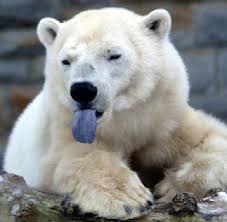 |
| The black tongue and nose match all his skin under his fur |
 |
| A dinner plate covered in tire tread |
They are also well adapted to walking across ice. The feet of a male polar bear can be 12" in diameter (about the size of a dinner plate). The bottoms of their paw have black pads which are covered with papillae, tiny bumps that act like the tread on a snow tire. They also have thick fur that gives them excellent traction. This makes it possible for them to creep along the ice to sneak up on a ringed seal. Two inch long claws top off these formidable paws and can be used for traction, to dig in thick ice, and to kill or disable prey. The broad paws also act like paddles to help the "sea bear" swim through artic waters.
| The nose knows |
 |
| Ice Bears |
| Ringed Seal Just Under the Ice |
| Seal Comes Up For Air |
 |
| Bear Waits Patiently for Seal to Surface |
During the summer months when there is no ice, the bears can't hunt for seals. They have to be fat enough to survive until the ice returns. The ice has started to form later and melt earlier every year. This means that polar bears have less time to feed and more and more bears are dying of starvation. Mother polar bears are having more and more single births due to food shortages.
for more information on Polar Bears, check out the Polar Bears International Web Site.
Here's the video I took of our polar bear, Nikita at the Kansas City Zoo. He's a four year old bundle of energy, who already weighs 830lbs. He'll keep growing for another two years or more. He loves to swim up to the visitors at the window and push off.
Friday, February 11, 2011
Fonetic Friday: Word of the Day
I'm bored with Fonetic Friday so I decided to do something different today.
For some reason I just can't seem to get New Orleans out of my head lately. I dream of being able to pack up my stuff every winter and move down there for January and February. I've even started looking at houses for sale, (even though I can't in anyway shape or form afford it, let alone get off work for two months every year.)
So what about you? Do you dream of having a house in a warmer climate during the winter, if so where? Do you already have one? What about people in other countries, Do people have winter homes/summer homes? What are the "hot spots"?
For some reason I just can't seem to get New Orleans out of my head lately. I dream of being able to pack up my stuff every winter and move down there for January and February. I've even started looking at houses for sale, (even though I can't in anyway shape or form afford it, let alone get off work for two months every year.)
So what about you? Do you dream of having a house in a warmer climate during the winter, if so where? Do you already have one? What about people in other countries, Do people have winter homes/summer homes? What are the "hot spots"?
Wednesday, February 9, 2011
What I Love about You Wednesday
Happy Wednesday. It's my pleasure to introduce you all to one of earliest followers, Sharon Kirk Clifton.
This lovely lady is from Indiana. Not only is she a writer, she's also a storyteller. This is a skill that I'd love to develop myself, so I'm always interested in the art of oral interpretations of literature.
She's written two middle-grade novels, and teaches eight graders. I always tip my hat to teachers, they're the foundation of our society.
She infuses her blog with her love for Christ, writing, storytelling, kids, and Indiana.
Thank you Sharon for being a follower. Check out her blog here.
This lovely lady is from Indiana. Not only is she a writer, she's also a storyteller. This is a skill that I'd love to develop myself, so I'm always interested in the art of oral interpretations of literature.
She's written two middle-grade novels, and teaches eight graders. I always tip my hat to teachers, they're the foundation of our society.
She infuses her blog with her love for Christ, writing, storytelling, kids, and Indiana.
Thank you Sharon for being a follower. Check out her blog here.
Monday, February 7, 2011
Zoosday Tuesday
My planned Zoosday Tuesday post is going to have to be postponed until next Tuesday. I'm having technical difficulties with my computer. I went to the zoo and got some great video of our polar bear, I'm going to get it transferred to my computer and get it posted for next week.
Thanks for visiting. Stop back next Tuesday for a post about polar bears.

Thanks for visiting. Stop back next Tuesday for a post about polar bears.

Friday, February 4, 2011
Fonetic Friday: Word of the Day
Hey, you know those cool words they make you type when you comment on a blog, the ones that prevent spammers from commenting? If they were real words, what would they mean? See if you can come up with a definition and use it in a sentence.
Today’s word is: Herymor
This is a fabulous new hair replacement product. You just cover the desired area with the thick foam substance, let it dry, and within 24 hours you will have 5 inches of new hair growth.
I accidentally put my husbands herymor on my legs, now I have to french braid my leg hairs.
Have fun! HAPPY FRIDAY!
Today’s word is: Herymor
This is a fabulous new hair replacement product. You just cover the desired area with the thick foam substance, let it dry, and within 24 hours you will have 5 inches of new hair growth.
I accidentally put my husbands herymor on my legs, now I have to french braid my leg hairs.
Have fun! HAPPY FRIDAY!
Wednesday, February 2, 2011
What I Love About You Wednesday
Happy Wednesday!
I'm sending Love to Lynda R Young whose blog WIP It is totally amazing. Lynda is a marvelous woman from down under! I was so excited that one of my very first followers was from Sydney Austrailia! It's so cool to me that someone in Kansas has a blogging buddy in Austrailia. (And now I have several).
Anyway, Lynda is a fabulous writer, but also an artist and photographer. Check out her blog, not only does she always have great advice, she also takes great pictures and posts them. Read
her story, I know you'll find you have a lot in common with Lynda.
So check out Lynda's blog if you haven't already. And Thank You Lynda for being a follower.
I'm sending Love to Lynda R Young whose blog WIP It is totally amazing. Lynda is a marvelous woman from down under! I was so excited that one of my very first followers was from Sydney Austrailia! It's so cool to me that someone in Kansas has a blogging buddy in Austrailia. (And now I have several).
Anyway, Lynda is a fabulous writer, but also an artist and photographer. Check out her blog, not only does she always have great advice, she also takes great pictures and posts them. Read
her story, I know you'll find you have a lot in common with Lynda.
So check out Lynda's blog if you haven't already. And Thank You Lynda for being a follower.
Tuesday, February 1, 2011
Zoosday Tuesday
***Any opinions expressed on this blog are mine alone, and do not reflect the opinions of the Kansas City Zoo.***
I decided to do one last animal from Indonesia before moving to a different region of the world. The Malayan Sun Bear is the smallest of the eight bear species, with males weighing up to 140lbs. and females around 120lbs. They lie mainly in the Maylay peninsula, and the Indonesian islands of Sumatra and Borneo, but there are some small pockets of Sun Bears as far away as India.
The Sun Bear gets it's name from the white or golden sun shaped crest on it's chest. These can vary in size and shape. They also have golden coloring around their eyes and muzzle.
Like all bears the sun bear's sense of smell is very powerful, but this bear also has a very impressive tongue. They use their super long tongue to scoop tasty food like termites and larve out of trees. But they also use it to lap up their favorite food, HONEY. They are also known as the Honey Bear.
The sun bear uses his claws to dig into trees and fallen logs to extract insects and honey. They also eat fruit, leaves, and small animals like lizards and amphibians. The sickle shaped claws and over sized canines of the sun bear make them a formidable opponent for even the largest predators like tigers. They also have loose skin around their neck and upper back that make it possible for them to turn, even in the clutches of a predator and strike with their teeth and claws.
I'm sure you won't be surprised to find that these bears number one predator is man. They have have all of the same issues that plague the other Indonesian animals we've discussed, namely habitat destruction. But like the tiger, these bears are also hunted for body parts used in ancient Chinese medecine. Namely the bile, from the gall bladder of bears is believed to have medicinal properties, used to treat rheumatism.
Sun bears don't hibernate like their cousins to the north, so they can reproduce at any time of the year. (Although they're difficult to study in the wild, there is some evidence that they may be monogomous, but the father is not involved in rearing the cubs.) The mother gives birth to one to two cubs after a 3 month gestation. The cubs weigh just under a pound at birth, and are blind and hairless. Within 3 months they are able to follow their mom around. Unlike most bears, the sun bear has been known to carry her cub by cradling it in her arms and walking upright.
Sun bears are primarily nocturnal and like to spend their nights foraging in trees. During the day, the spend most of their time sleeping in the trees.
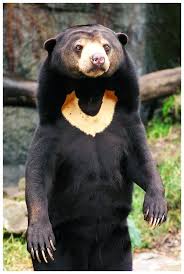 |
| MALAYAN SUN BEAR |
I decided to do one last animal from Indonesia before moving to a different region of the world. The Malayan Sun Bear is the smallest of the eight bear species, with males weighing up to 140lbs. and females around 120lbs. They lie mainly in the Maylay peninsula, and the Indonesian islands of Sumatra and Borneo, but there are some small pockets of Sun Bears as far away as India.
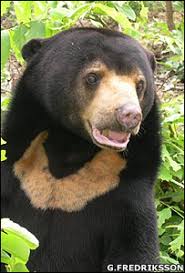 |
| Sun Shaped Crest on Chest |
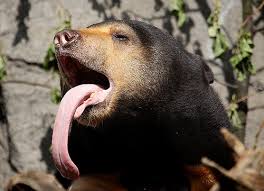 |
| Check out that tongue |
 |
| Oversized Canines |
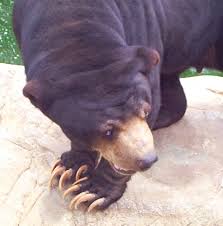 |
| Sickle-shaped claws |
I'm sure you won't be surprised to find that these bears number one predator is man. They have have all of the same issues that plague the other Indonesian animals we've discussed, namely habitat destruction. But like the tiger, these bears are also hunted for body parts used in ancient Chinese medecine. Namely the bile, from the gall bladder of bears is believed to have medicinal properties, used to treat rheumatism.
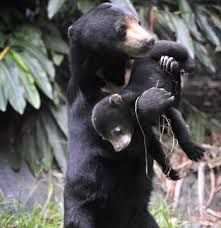 |
| Mother cradling baby |
Sun bears are primarily nocturnal and like to spend their nights foraging in trees. During the day, the spend most of their time sleeping in the trees.
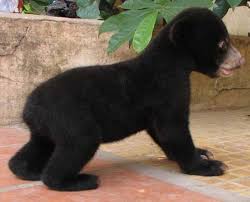 |
| Sun Bear Cub |
Subscribe to:
Comments (Atom)